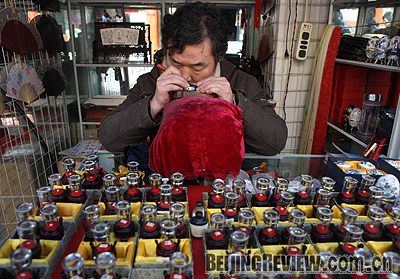| 
CLOSE UP: A craftsman in Liulichang works carefully on a micro-sculpture
Liulichang is a colorful street in Beijing that also has a colorful name, literally.
Located near Hepingmen, in the Chongwen District of Beijing, Liulichang translates into "factory for making colored glass." The name derives from the Yuan Dynasty (1279-1368), when the government set up a factory here for making colored glass, the scale of which was enlarged in the Ming Dynasty (1368-1644), making it one of the five largest factories in the city. After the neighborhood was incorporated into the urban area, the factory was moved to the suburbs, but the name Liulichang remained.
In the Qing Dynasty (1644-1911), when people from across China came to Beijing for the imperial civil examinations, they mainly lived in Liulichang, and their presence transformed the area into a gathering place for book and stationery shops. Gradually, Liulichang developed into a book-selling center that attracted vendors from around the capital.
In 1772, Qing Dynasty scholars started to compile the Complete Library in the Four Branches of Literature at the order of Emperor Qianlong. During the compilation process, they often went to Liulichang for reading and research.
Aside from the area's bookstores, antique shops and vendors selling other cultural items have now moved in. Some more established shops, such as China Bookstore, have also opened in the neighborhood.
| 